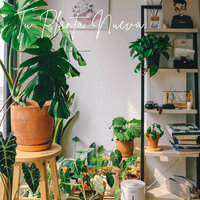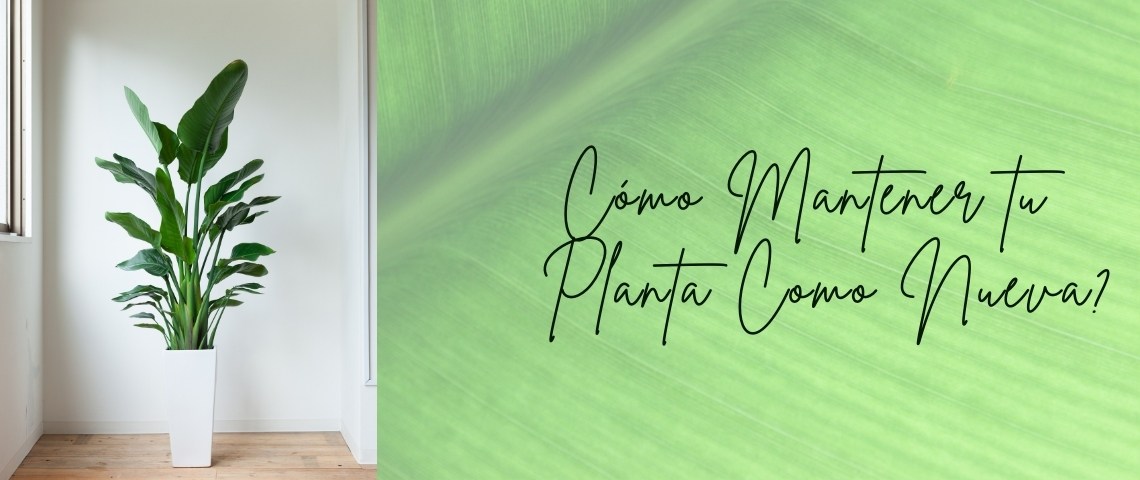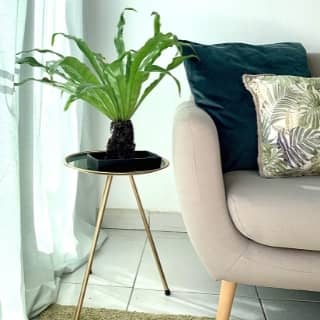-
Create the best atmosphere at home for your new plant

''¡Ding dong!'' It's the delivery man and he has a little something for you. Your most desired plant has just arrived at your little house or you have just bought it in your plant shop and now you are wondering: how can I make it feel happy so that it stays this beautiful with its fresh green leaves.
We all want to have a healthy and beautiful plant for a long time. A happy plant will make us happy. We will explain how to find the best balance for your new 'green jewel'. Whether it's a monstera, alocasia, ficus, philodendron or calathea: all plants need your pampering.
your new plant
At the beginning the leaves of your plant are so beautiful because in the nursery they grow under ideal conditions. They receive perfect light, they have the right humidity, the watering system is fully automated. In the nursery, the light does not only come from the side, but mainly from above. Of course, this is because the greenhouse roof is made of plastic or glass. In addition, the light in a nursery is very uniform, so the plant grows quickly upwards, as the leaves are naturally oriented towards the light.
their natural habitat vs. their new home
The light in your living room is usually much less uniform. It tends to reach your plant mostly from one side, namely from where the nearest window is. And it is not from above, which is what a plant is used to, both naturally and in the greenhouse. As the leaves still face the light, they are likely to droop a lot more or grow in one direction.
understanding a plant
There are many times when plants end up dying even though we take care of them and pay attention to them, because we do not understand their needs properly.

new environment
All the plants you bring into your house have to get used to their new environment. The light is different, the temperature is different, the amount of water is different and so on. During this period, some plants may drop their leaves or lose a leaf. There is nothing to worry about, especially if only the oldest leaves of the plant are lost. In the case of Alocasia, it is the smaller leaves, which are located on the outside of the stem at the bottom. Once the plant has acclimatised, no more leaves will die, but new leaves or stems will appear.
repoting your new houseplant
Indoor plants or houseplants are sold in a nursery pot. Actually, this pot is just the right size for the roots. Before repotting, you need to wait about two weeks after you have received (or bought) your desired plant. It's advisable to remove the plastic pot from the nursery and transplant the plant into a larger (ornamental) pot. Choose a pot that is one or two centimetres larger. This will give the plant enough room to grow and universal potting soil can be added (this soil has new nutrients).
watering frequency and water quantity

Both too much and too little water can cause Alocasia leaves to fall off. When there is too little water, it is logical; water gives the plant firmness and when there is too little, everything starts to fall off. The solution is simple: give it more water and see how your plant recovers in a few hours. With too much water, this is less logical. If your plant receives too much water by default, but not so much that it dies, it can start to grow too fast. The stems then become too long and can no longer support the weight of the leaves. This can also happen with ZZ plants, for example.
lack of or too much light
The light in our homes is often very one-sided and irregular. Lack of light for plants can also lead to leaf drop. On the one hand, the plant can generate less energy and this can lead to death and leaf drop. On the other hand, it can result in your plant making long stems in an attempt to get closer to the light. If the stems are too long for the weight of the leaf, the leaves will hang down and the plant will look less beautiful.
the perfect plant
Now we come to a cruel point. We don't say this to spite you, but the first thing to accept is that your plant will not usually look as perfect as you bought it. It will always look slightly different, but that also makes your plant unique. In addition, you should ensure the best possible conditions for your plant. The better it is cared for, the more likely it is to stay standing. If you really want a perfect plant with no rolls, buy an artificial plant!
buy your plant
With these basic guidelines, you can start taking care of your little ones, whether you are setting up a small garden, an urban jungle or simply have a beautiful plant on your desk. Keep in mind that they themselves will be the ones to tell you if everything is going well or if something is going wrong and not allowing them to grow peacefully. Listen to them, take care of them and watch them grow splendidly.
Que haver cuando las hojas se vuelven amarillas de la alocacia ?
Hojas amarillas, que hacer?
Hola Carmem. Gracias por tu pregunta. Las hojas de las Alocasias suelen tener los bordes amarillos a causa de sobreriego. A veces también es normal. Las hojas más viejas suelen dejar de estar verdes. De esta manera la planta puede dar su energía a otras hojas (nuevas) Es un proceso de renovación. Nuestro consejo: con cuidado con el riego. No dejes que se seque el sustrato entre riegos pero no lo dejes muy húmedo siempre. También podrías darle algo de fertilizante líquido para que crezca mejor. Saludos.